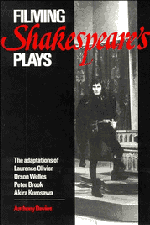 Filming Shakespeare's Plays
Filming Shakespeare's Plays Book contents
- Frontmatter
- Contents
- List of illustrations
- Preface
- Acknowledgements
- Introduction
- 1 Theatrical and cinematic space
- 2 Laurence Olivier's HENRY V
- 3 Laurence Olivier's HAMLET
- 4 Laurence Olivier's RICHARD III
- 5 Orson Welles's MACBETH
- 6 Orson Welles's OTHELLO
- 7 Orson Welles's CHIMES AT MIDNIGHT
- 8 Peter Brook's KING LEAR and Akira Kurosawa's THRONE OF BLOOD
- 9 The film actor
- Conclusion
- Notes
- Select filmography
- Bibliography
- Index
8 - Peter Brook's KING LEAR and Akira Kurosawa's THRONE OF BLOOD
Published online by Cambridge University Press: 01 June 2011
- Frontmatter
- Contents
- List of illustrations
- Preface
- Acknowledgements
- Introduction
- 1 Theatrical and cinematic space
- 2 Laurence Olivier's HENRY V
- 3 Laurence Olivier's HAMLET
- 4 Laurence Olivier's RICHARD III
- 5 Orson Welles's MACBETH
- 6 Orson Welles's OTHELLO
- 7 Orson Welles's CHIMES AT MIDNIGHT
- 8 Peter Brook's KING LEAR and Akira Kurosawa's THRONE OF BLOOD
- 9 The film actor
- Conclusion
- Notes
- Select filmography
- Bibliography
- Index
Summary
Peter Brook and Akira Kurosawa have both made films which are, in their very different ways, logical extensions of the endeavours we have so far discussed, to accommodate Shakespearean drama in cinematic space. The plays involved here (King Lear and Macbeth) both demand a juxtaposition of the world of nature with the world of man, yet the directors are at opposite ends of a spectrum in the spatial strategies they employ. While Brook's King Lear seeks a spatial selectivity in order to heighten the effect of dialogue, Kurosawa's films Ran and Throne of Blood find a spatial articulation which almost dispenses with the need for dialogue. Both directors incorporate deliberate theatricality in their films, in pursuit of very different cinematic effects. Like Olivier, Brook has directed films yet he is most strongly associated with the theatre. Like Welles, Kurosawa is best know for films he has made. Both Brook and Kurosawa stand apart from Olivier and Welles in that neither is an actor. Their spatial strategies are, therefore, likely to be more objectively developed.
Like Olivier, Brook emerges from an eminent theatrical involvement with the works of Shakespeare. Like Welles he has shown himself to be original, unorthodox and experimental in his cinematic work. Of his five major films, only one is an adaptation of a Shakespeare play, and in all his work, he has expressly attempted to push forward the frontiers of cinematic potential.
- Type
- Chapter
- Information
- Filming Shakespeare's PlaysThe Adaptations of Laurence Olivier, Orson Welles, Peter Brook and Akira Kurosawa, pp. 143 - 166Publisher: Cambridge University PressPrint publication year: 1988


